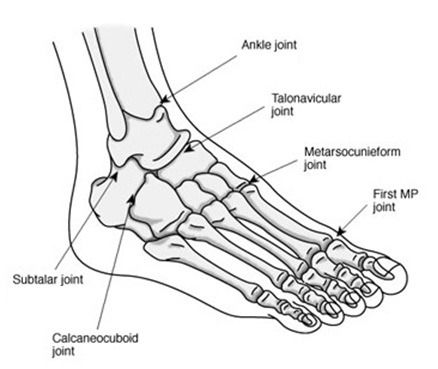Subtalar Arthritis
Subtalar arthritis is a type of arthritis which affects the subtalar joint, that is, the joint found below the ankle joint in the hindfoot. The condition is characterised by pain in the hindfoot area, which can be aggravated by walking, especially on an uneven surface, and standing. The specific location of the pain is the level of the hindfoot which is just below the outside of the ankle.
REQUEST AN APPOINTMENT
Causes
The most common cause of subtalar arthritis is trauma due to an injury such as a calcaneal fracture, or abnormal heel bone alignment. However, there are also other fractures which involve the talar body, that can cause subtalar arthritis. Incidents which can lead to subtalar arthritis often involve an uneven distribution of weight, causing the heel bone to turn either in or out.
Symptoms
When you have subtalar arthritis, you may experience pain on both sides of the foot, or just the outer side, from just below the ankle. Pain can also be felt from the dip which is found in front of the outer ankle bone. Because the subtalar joint – which is made up of the talus and calcaneus, and the space known as the sinus tarsi – plays an important role in allowing us to walk along uneven surfaces, subtalar arthritis may make it extremely difficult to walk on this type of ground, due to the stress which is placed on the joint.
You might find that subtalar arthritis symptoms get worse in cold weather, and that stiffness is especially bad in the mornings. Other common symptoms of subtalar arthritis include inhibited movement of the joint, swelling and a joint deformity, caused by a change in foot shape.

Treatment
In making a diagnosis of subtalar arthritis, imaging tests such as an x-ray, and sometimes CT or MRI scans, may be used.
Among the non-surgical treatment options for subtalar arthritis are weight loss programmes, which help to reduce the amount of weight which is placed on the hindfoot, decreasing the forces which go through it; modifying activities to reduce the amount of walking and standing which is done, especially on uneven surfaces; ankle bracing, often using an ankle brace, which can limit the forces going through the joint; more comfortable shoes, which can offer more shock absorption in the heel area; and the ice and elevation routine, which ices the ankle and hindfoot region, and elevates the leg in order to reduce both swelling and pain.
Medications which can be prescribed for the condition include nonsteroidal anti-inflammatory drugs (NSAID) such as Ibuprofen, and paracetamol. Corticosteroid injections can also be used to offer pain relief, but it should be noted that the relief is typically temporary.
Subtalar fusion is the most common surgical treatment of subtalar arthritis. The procedure, also known as subtalar arthrodesis, involves the clearing of cartilage remnants from the joint, before the placing of bone grafts and screws across the joint. At the Sussex Foot & Ankle Clinic this can often be done arthroscopically (keyhole) through small incisions on the heel and side of the foot. This can be done as a one-night stay surgery but does require 6 weeks of non weight-bearing in a plaster cast to allow the fusion to heal.
As with all foot surgery, it is common for swelling to persist for some months after surgery and is completely normal. This swelling will eventually completely subside with time and can take up to 12 months but often goes well before this.
Ankle pain can be distressing, especially if you're not sure what options are open to you. If you're wondering if surgery could help you, book an appointment.
* Routine private appointments either face to face or remotely are available
